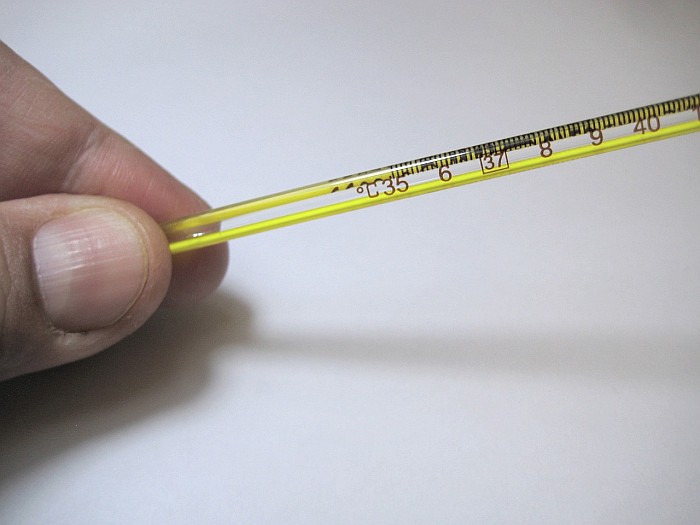From time to time, dog owners often get the impression that their pooch isn’t feeling especially well.
Maybe your little four-footer has the sniffles, or maybe she just isn’t acting like herself. Maybe her tummy has been upset all day, or she isn’t showing interest in her food.
Regardless of the signs that are causing you concern, you need to determine if she’s just having a bad day or she needs to go to the vet.
Taking her temperature is one of the first things you’ll want to do, and fortunately, it is pretty easy to do so — a little intimate, perhaps, but relatively easy.
Best Dog Thermometers: Quick Picks
- #1 iProven Pet Thermometer [Best Overall]: The iProven Pet Thermometer received the best reviews of any pet thermometer we examined, and your pooch’s posterior will surely appreciate the flexible tip.
- #2 Hurinan Digital Pet Thermometer [Easiest to Use]: The Hurinan Thermometer’s angled handle makes it very easy to hold and use. Additionally, it features a large display screen, which makes it easy to see your pet’s temperature.
- #3 ADC Veterinary Thermometer [Most Affordable]: Most of the thermometers we reviewed are about the same price, but if you’re trying to save every possible penny, this model will save you a bit of cash.
Best Thermometers For Dogs: Our Top Picks
The following four thermometers are great choices for your pup. Just be sure to look them all over carefully before picking one out.
1. iProven Pet Thermometer
About: The iProven Pet Thermometer is a straight-forward, easy to use, and affordable pet thermometer. It features a flexible tip for safety, and it registers your pet’s temperature in only 20 seconds.
This is a sponsored placement, in which an advertiser pays a fee to be featured in this article. Learn more
Pros
- Easy to use
- Flexible tip helps avoid some discomfort for your pet
- Comes with hard plastic carrying case
Cons
- It takes quite a while to provide a temperature reading
- Poor battery life
2. Hurinan Digital Pet Thermometer
About: The Hurinan Digital Pet Thermometer is an angled digital thermometer, which is suitable for taking axillary or rectal temperatures. It is easy to hold, it doesn’t require probe covers, and it is accurate to ±0.2°F.
This is a sponsored placement, in which an advertiser pays a fee to be featured in this article. Learn more
Pros
- Most owners found it easy to use
- Angled handle makes it easy to hold
- Easy-to-read display
Cons
- Takes a while to provide a temperature reading
- Larger and bulkier than many other options
3. ADC Veterinary Thermometer
About: The ADC Veterinary Thermometer is an accurate and easy-to-use thermometer designed specifically for use with pets. You can use this thermometer to obtain your dog’s temperature from either her armpit or her rectum.
This is a sponsored placement, in which an advertiser pays a fee to be featured in this article. Learn more
Pros
- Easy to use
- Comes with carrying case and disposable sleeves
- Affordable
Cons
- This thermometer doesn’t alert you that the temperature has been read with an audible beep
4. Enji Family Digital Thermometer
About: The Aurynns Pet Thermometer is an easy-to-use thermometer, with all of the basic features you’d expect. An effective and accurate tool, the Enji Family Thermometer is appropriate for taking your dog’s temperature via her rectum or armpit.
This is a sponsored placement, in which an advertiser pays a fee to be featured in this article. Learn more
Pros
- Easy to use
- Automatic-off function saves battery life
- Comes with audible temperature alarm
Cons
- Takes about 20 seconds to determine your pet’s temperature
Our Recommendation: The iProven Pet Thermometer
Any of the five thermometers discussed above should help you monitor your pet’s body temperature, but the iProven Pet Thermometer is likely the best of the bunch. It is easy to use, affordable, and accurate, and it received the best customer reviews of the options available.
Where Do You, Uh, Put It?
It may not be pretty, but the best place to take your dog’s temperature is her rectum.
It may seem more polite to just take your dog’s temperature orally, but few dogs could be trusted to hold the thermometer under their tongue gently – most would bite down on the thermometer. This will ruin a digital thermometer and it could lead to very serious problems in the case of a mercury thermometer.
Rectal temperatures have been studied extensively, and researchers have amassed plenty of data supporting their accuracy. Dr. Ken Tudor characterizes rectal temperatures as the “gold standard” of temperature measurements.
However, few dogs are swayed by empirical data, and most would rather not have a thermometer enter their exit. Some dogs take the indignity fairly stoically, and only offer a mournful look that makes you feel horrible; others lose their mind, frantically trying to get away from the probing instrument.
This is not only upsetting to both pet and parent, it can occasionally result in inaccurate temperature readings. Accordingly, some vets and owners opt to take their dog’s temperature in other ways.
Rectal temperatures aren’t always perfect either, and they sometimes provide inaccurate temperatures too.
However, this usually happens for one simple reason: The thermometer has been inserted into feces. To prevent this, try to gently press the thermometer against the wall of the rectum once you’ve inserted it.

Axillary (armpit) temperatures can be taken, but these are not as accurate as rectal temperatures are. This is most noted at the lower ends of the dog temperature spectrum. However, many vets rely on axillary temperatures when rectal temperatures cannot easily be obtained.
It is also possible to take a dog’s temperature via the ear canal (called an auricular temperature). Many veterinarians use this technique because it doesn’t usually upset dogs and their owners as much as rectal temperatures do.
Auricular temperatures are fairly accurate, but research has demonstrated that they are not as accurate as rectal temperatures are either. Some even argue that they aren’t suitable for clinical purposes. Additionally (as we’ll discuss below), there aren’t many good auricular thermometers for dogs on the consumer market.
At the end of the day, the best approach is to take your dog’s temperature rectally, unless you or your dog is strongly opposed to the notion. In such cases, you’ll just have to rely on an axillary temperature, and realize that the reading may not be as accurate as would be ideal.
What Kind of Thermometer Do You Need for Your Dog?
There’s nothing intrinsically different about taking your dog’s temperature than from taking your own. You need to obtain a good core body temperature, and – in principle – any properly calibrated temperature-sensing tool will work.
However, there are three different types that are most commonly used for dogs:
- Mercury
- Digital
- Infrared
Mercury and digital thermometers are the most popular choices for most dog owners. Most are both easy to use and affordable.
You can use either of these to take your dog’s temperature rectally or via the armpit. Some vets (and the AKC) discourage the use of glass thermometers for safety reasons. Most owners opt for digital, as they are the most prevalent and easy to read.
You’ll need an infrared thermometer to take your dog’s auricular temperature, but not just any infrared thermometer will do; you’ll have to obtain one designed specifically for dogs.
Unfortunately, we can’t find any good auricular thermometers for owners (if you know of any, please share the info in the comments).
There are a few very high-priced models intended for veterinary use on the market, but most auricular thermometers designed for owners to use are simply re-packaged non-contact thermometers.
These won’t work for your dog. So, in practice, you’ll usually need to take your pup’s temperature via her rectum or armpit.
The Procedure: How to Take Your Dog’s Temperature
Follow the steps outlined below to obtain the most accurate temperature possible for your dog. Regardless of the method you choose, it is always a good idea to have another person nearby to help hold your dog during the process.
Taking Your Dog’s Rectal Temperature
Begin by establishing a calm and relaxed space where your dog feels comfortable. Rinse the thermometer off to remove any dust or debris that may be present, but you don’t need to sterilize it, as it isn’t exactly going into a sterile place.

Have your helper hold the dog gently, and sit or kneel beside them. Give your pooch a few pats to reassure her and keep her calm (if you don’t have a helper, have your dog lay on her side). You’ll then want to apply a very small amount of petroleum jelly (Vaseline) to the tip of the thermometer.
While holding the thermometer in your right hand (assuming you are right-handed), lift your dog’s tail with your left hand.
Now comes the moment of truth: Locate your target, and gently(!) slide the thermometer into her rectum with a twisting motion. Be sure that you do not insert a thermometer too far – 1 to 3 inches (depending on the size of your dog) is sufficient.
Once the thermometer is inside your dog’s rectum, you’ll need to keep her calm and relaxed until the thermometer has reached the temperature of her rectum.
Digital thermometers will beep once they’ve obtained the correct temperature, but you’ll need to check the manufacturer’s guidelines to learn how long this should take for a mercury thermometer (usually about two minutes).
After the necessary time has passed, gently pull the thermometer back out. Let your dog run off in shame and praise her for being a good widdle wady.
Check the temperature displayed on the thermometer (you may have to wipe it off first – blech), before washing it and your hands thoroughly. Then, you’ll want to sterilize the thermometer (at least the probing portion of it) by soaking it in a bit of rubbing alcohol for a few minutes.
Check out this handy video below to see the process in action:
Taking Your Dog’s Axillary Temperature
Taking an axillary temperature is a good bit easier than taking your dog’s temperature rectally.
Start by having your dog assume the “sit” position. Kneel down beside her with a clean thermometer in hand – you may want to let her sniff the thermometer a bit to satisfy her curiosity and allay any anxiety.
Gently insert the thermometer between your dog’s front leg and her chest. While waiting for the thermometer to do its thing, you’ll want to try to keep your dog as immobile as possible, while still keeping her calm. Some gentle ear rubbing may help keep her happy and relatively still.
Once the thermometer beeps or the correct amount of time has passed, remove the thermometer, note the reading and let your pooch go on her way. Wash the thermometer and your hands, and then you’re done.
Taking Your Dog’s Auricular Temperature
Your dog probably won’t mind having a thermometer inserted into her ear nearly as much as she would a thermometer inserted into her butt, so auricular temperatures are often easier to take from an animal-control point of view.
However, as we discussed earlier, there aren’t any good auricular thermometers available for dog owners, unless you are willing to spend a few hundred dollars on a veterinary-grade version.
Accordingly, we’ll describe how auricular temperatures are taken, but it’s pretty much for informational purposes only.
To effectively take an auricular temperature, you need to bounce a beam of light off your dog’s ear drum. And this means you’ll need to understand a bit about your dog’s ear anatomy.
Your dog’s ear canal is L-shaped. Just inside the ear, the canal makes a (more or less) 90-degree turn toward the bottom of her skull (this is called the vertical ear canal). The canal then makes another 90-degree turn, which forms the horizontal ear canal, which ends at the ear drum. In other words, to reach the ear drum, you’d have to go in, then down, then in again.
To obtain an accurate auricular temperature, you need to insert the probe of the infrared thermometer into the horizontal portion of the ear canal.
But before inserting the thermometer into your dog’s ear, you’ll want to place a protective cover over the end. After doing so, you can sit beside your dog and try to insert it into her ear.
Wait for the thermometer to beep before withdrawing it, and then discard the protective cover. Clean the thermometer off in accordance with the manufacturer’s guidelines and wash your hands.
Normal Dog Temperature Range
The normal temperature range for dog’s is about 99.5 and 102.5 degrees Fahrenheit.
Temperatures of 103 or more indicate the presence of a fever and necessitate a phone call to the vet. Note that low temperatures can also indicate a problem, so pick up the phone if your dog’s temperature is below 99 degrees.
The temperature you obtain will vary slightly based on the location in which you took it.
While the temperature range listed above is typical for rectal temperature measurements, auricular temperature measurements often result in slightly higher readings, while axillary temperature readings are often a bit lower.
Common Causes for a Dog’s Fever
There are a variety of reasons that a dog can suffer a fever, but some of the most common include:
Urinary tract infections
Systemic bacterial or viral infections
Respiratory infections
Abscesses or infected wounds
Cancer
Immune mediated diseases
Heat stroke
Tick-borne diseases
Pancreatitis
Recent vaccination
Generally, infections are one of the most common reasons for your dog to develop a fever, as the elevated body temperatures are your dog’s way of killing off the offending bacteria or virus.
Most bacteria and many viruses function best within a very narrow temperature range, which usually corresponds with your dog’s normal body temperature. But when your dog’s body temperature rises, the invading pathogens begin struggling to survive.
Emergency Fever Reduction For Dogs: What to Do With a Fever
Minor fevers are not necessarily dangerous. You’ll want to give your dog’s vet a call, but you don’t need to jump in the car and head right over, unless the temperature reaches 103 or your vet instructs you to do so.
However, in some cases, it may be necessary to reduce your dog’s temperature very quickly. Your vet may instruct you to do so if your dog’s temperature is dangerously high. Temperatures of 106 degrees, for example, may severely damage your pet’s internal organs.
The best way to do so is by dampening your dog’s paws and ears with some cool water. These locations are both great radiators of heat, and by wetting them, you also leverage the cooling powers of evaporation. You could also place a fan in front of your pooch to help bring her temperature down.
In fact, some vets instead recommend wetting your dog’s paws (but not her ears) with a little rubbing alcohol. Rubbing alcohol evaporates even more quickly than water, which means it can cool your pet more quickly.
***
How do you take your dog’s temperature? Does she tolerate a thermometer being slid into her rear end, or do you have to take axillary or auricular temperatures? We’d love to hear about your experiences in the comments below.



















Leave a Comment